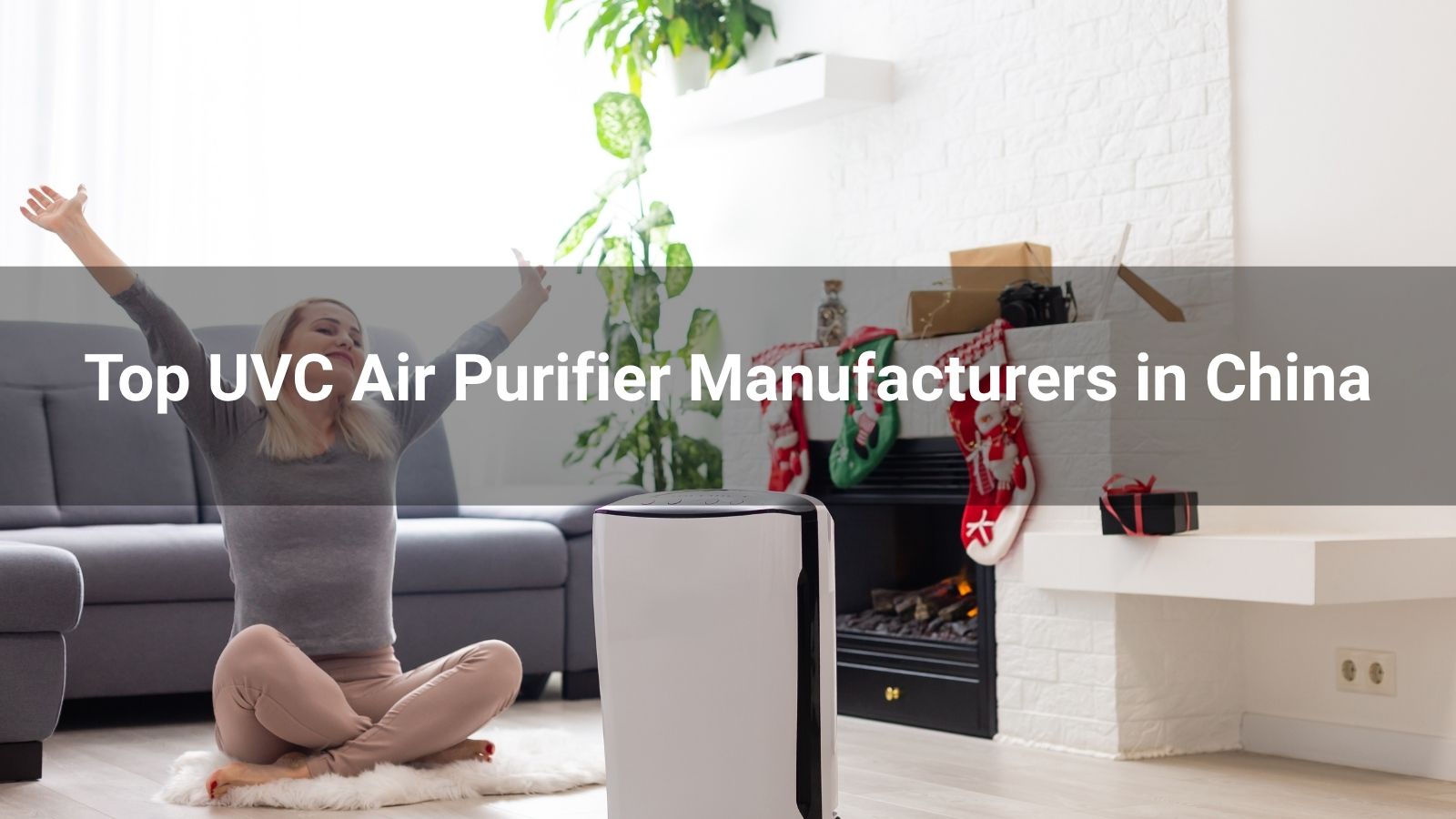
Choosing between UVC ceiling-mounted air purifiers and wall-mounted air purifiers depends on your specific needs, space constraints, budget, and operational goals. Both leverage ultraviolet C (UVC) light at 254nm to neutralize up to 99.9% of airborne pathogens, including bacteria, viruses, and molds, by disrupting their DNA. When paired with HEPA filtration and efficient airflow, they create a robust defense against indoor air pollutants. However, their differences in installation, coverage, aesthetics, and maintenance make each suited to distinct environments. Below, we analyze each system, compare their applications, and provide a strategic framework to help you decide.

A UVC air purifier is a device that utilizes ultraviolet C (UVC) light, typically at a wavelength of 254 nanometers, to neutralize airborne pathogens such as bacteria, viruses, molds, and other microorganisms by disrupting their DNA or RNA, rendering them inactive. Unlike traditional air purifiers that rely solely on filters like HEPA to trap particles, UVC purifiers actively destroy microbes, offering a higher level of disinfection. These devices, including models like the Pro Series Laminar Flow Air Purifier, Wall-Mounted UVC Air Purifier, Laminar Flow Air Purifier, Ceiling Type Air Purifier, Thin Partitioned Air Purifier, and Ultraviolet Mobile Air Purifier, are widely used in homes, offices, healthcare facilities, and schools to improve indoor air quality and reduce the spread of infectious diseases.

Overview: Ceiling-mounted UVC air purifiers are integrated into drop ceilings (e.g., 2x2 or 2x4 grid panels) or HVAC systems, offering a discreet, high-capacity solution for air disinfection. They are designed for large, high-traffic spaces, leveraging upper-air circulation to maximize pathogen control.
Key Features:
-
Installation: Requires professional installation, often involving electrical wiring and ceiling access. Integration with existing HVAC systems or standalone recirculation units is common. Lead times can range from 8-10 weeks, with potential workflow disruptions during retrofitting.
-
Coverage: Excels in large spaces (up to 2,000 sq ft), achieving 10+ air changes per hour (ACH). The top-down airflow creates a stratified layer of sanitized air, ideal for reducing cross-contamination in crowded environments.
-
Airflow Dynamics: Utilizes convection to draw air upward, purify it via UVC exposure, and release clean air downward. This "upper air" approach ensures broad coverage, particularly effective in high-ceiling environments (8-9 ft recommended).
-
Aesthetics: Blends seamlessly with ceiling fixtures, resembling light panels or vents. This preserves floor and wall space, maintaining a clean, professional look.
-
Maintenance: UVC bulbs last 9,000–18,000 hours (1–2 years), and HEPA filters require replacement every 6–12 months. Accessing ceiling units for maintenance can be challenging, often requiring ladders or professional assistance.
-
Energy and Noise: Consumes 20–50W, with ultra-low noise levels (fan optional), making them suitable for 24/7 operation in noise-sensitive settings like hospitals or classrooms.
-
Cost: Initial costs range from $500–$1,500, with professional installation adding $200–$500. Long-term savings may offset this due to efficient, large-scale operation.
Advantages:
-
Superior coverage for large, open spaces.
-
Discreet, space-saving design enhances aesthetics.
-
High ACH rates ensure hospital-grade disinfection, backed by studies (e.g., NHS, EPA) showing efficacy against pathogens like MRSA and coronaviruses.
Challenges:
-
High upfront cost and installation complexity.
-
Limited portability, making them less adaptable to changing space needs.
-
Maintenance may require specialized access, increasing long-term costs.
Ideal Use Cases:
-
Healthcare Facilities: Clinics, hospitals, and dental offices benefit from ceiling units’ ability to maintain sterile environments in patient rooms or waiting areas.
-
Educational Institutions: Classrooms and lecture halls leverage broad coverage to protect students and staff in high-density settings.
-
Large Residences: Spacious homes with open-plan layouts or high ceilings achieve comprehensive air purification without sacrificing aesthetics.

Overview: Wall-mounted UVC air purifiers are compact, versatile units that mount flush against walls, often in corners to optimize airflow. They are designed for smaller, targeted spaces and offer flexibility for residential or small commercial settings.
Key Features:
-
Installation: DIY-friendly, requiring minimal tools and brackets. Installation takes hours, not days, and many units are lightweight (e.g., 5.5 lbs) and detachable for portability. Some models double as portable floor units.
-
Coverage: Effective for smaller spaces (120–500 sq ft), with targeted airflow delivering 4–8 ACH. Multiple units may be needed for larger areas, increasing costs.
-
Airflow Dynamics: Pulls air horizontally across the room, often using fans to direct flow. Some models feature "upper air" variants that angle UVC exposure upward, but they are less effective at whole-room circulation compared to ceiling units.
-
Aesthetics: Sleek and modern (e.g., 13" x 5" x 11.7"), but visible on walls, potentially clashing with minimalist designs or tight spaces. They add a tech-forward accent, appealing in contemporary homes.
-
Maintenance: UVC bulbs have a similar lifespan (9,000–18,000 hours), but HEPA filters may need replacement every 3–6 months due to higher dust exposure in lower air zones. Wall access simplifies maintenance.
-
Energy and Noise: Consumes 15–36W, often with app or remote controls for energy-efficient modes (e.g., timed sleep). Fan noise may be noticeable in small rooms, though generally low.
-
Cost: More affordable, ranging from $200–$800, with minimal installation costs. Quick return on investment due to lower upfront expenses.
Advantages:
-
Affordable and easy to install, ideal for budget-conscious users.
-
Portable and flexible, allowing relocation as needs change.
-
App integration enhances user control, optimizing energy use.
Challenges:
-
Limited coverage requires multiple units for larger spaces, increasing costs.
-
Visible footprint may disrupt aesthetics in small or crowded rooms.
-
Horizontal airflow is less effective for whole-room pathogen control in high-traffic areas.
Ideal Use Cases:
-
Residential Spaces: Apartments, bedrooms, or home offices benefit from compact, targeted purification.
-
Small Commercial Settings: Waiting rooms, small retail spaces, or private offices leverage affordability and ease of installation.
-
Temporary or Flexible Needs: Portable wall units suit renters or spaces requiring frequent reconfiguration.

|
Feature |
Ceiling-Mounted |
Wall-Mounted |
|
Coverage Area |
Up to 2,000 sq ft, 10+ ACH |
120–500 sq ft, 4–8 ACH |
|
Airflow |
Top-down, upper-air convection |
Horizontal, targeted flow |
|
Installation |
Professional, 8-10 weeks lead time |
DIY, hours to install |
|
Aesthetics |
Discreet, blends with ceiling |
Visible, modern but may disrupt design |
|
Cost |
$500–$1,500 + $200–$500 install |
$200–$800, minimal install cost |
|
Maintenance |
Bulbs: 1–2 yrs; Filters: 6–12 mos; Ceiling access |
Bulbs: 1–2 yrs; Filters: 3–6 mos; Easy access |
|
Energy Use |
20–50W, ultra-low noise |
15–36W, low noise (fan hum possible) |
|
Portability |
Fixed, non-portable |
Detachable, portable |
|
Best For |
Large, high-traffic spaces (clinics, schools) |
Small, flexible spaces (homes, small offices) |
Performance Comparison:
-
Pathogen Control: Ceiling units outperform in high-risk, high-traffic environments due to their top-down airflow and higher ACH, creating a "clean air curtain" above breathing zones. Wall units excel in localized purification but may struggle in larger or crowded spaces.
-
Scalability: Ceiling systems scale better for expansive areas, while wall units require multiple installations, increasing complexity and cost.
-
Integration: Ceiling units integrate with HVAC systems for whole-building solutions, whereas wall units are standalone, limiting their scope in complex setups.
Real-World Applications:
-
Ceiling Example: Lumalier’s UVGI ceiling units, used in hospitals, achieve 99.9% pathogen reduction in high-risk zones like surgical suites, leveraging upper-air UVC exposure (EPA-backed).
-
Wall Example: Midtherm’s MT250 wall/ceiling hybrid, ideal for corridors, eliminates 99% of pathogens in a single pass, offering flexibility for smaller commercial spaces (Jiajing Medical data).
To choose the right UVC air purifier, consider the following framework:
-
Assess Space Requirements:
-
Size and Layout: Measure your space’s square footage and ceiling height. Ceiling units suit spaces >500 sq ft with 8-9 ft ceilings; wall units are ideal for <500 sq ft or low ceilings.
-
Traffic and Risk: High-traffic or virus-prone areas (e.g., clinics) favor ceiling units for broad coverage. Low-traffic, private spaces (e.g., home offices) align with wall units.
-
Budget and Timeline:
-
Upfront Investment: Ceiling units require higher initial costs and professional installation. Wall units offer quicker, cheaper deployment.
-
Long-Term Costs: Factor in maintenance (filter/bulb replacements) and energy use. Ceiling units may save on maintenance frequency, while wall units reduce installation costs.
-
Aesthetic and Space Constraints:
-
Prioritize ceiling units for minimalist or professional environments where floor/wall space is premium.
-
Choose wall units for flexibility or spaces where visible tech aligns with the design.
-
Performance Goals:
-
For maximum pathogen control in high-risk settings, ceiling units’ upper-air circulation is superior.
-
For targeted, cost-effective purification, wall units deliver adequate performance.
-
Regulatory and Safety Compliance:
-
Ensure units are ozone-free and UL-certified for safe, continuous use in occupied spaces (EPA guidelines).
-
Verify UVC wavelength (254nm) and efficacy claims through third-party studies (e.g., NHS, Jiajing Medical).
Implementation Steps:
-
Consult Professionals: For ceiling units, hire certified HVAC or UVGI specialists to assess integration and compliance.
-
Test and Monitor: Use air quality monitors to baseline and track improvements post-installation.
-
Plan Maintenance: Schedule regular bulb and filter replacements, factoring in access challenges for ceiling units.
-
Scale Strategically: Start with a single wall unit for small spaces or pilot a ceiling unit in high-priority zones before full deployment.
Recommendations:
-
Choose Ceiling-Mounted Purifiers if you manage a large, high-traffic space (e.g., hospital, school, or open-plan office) where discreet, high-capacity air disinfection is critical. Their superior coverage, seamless aesthetics, and hospital-grade performance make them the gold standard for pathogen control in expansive or high-risk environments.
-
Choose Wall-Mounted Purifiers if you need an affordable, flexible solution for smaller spaces (e.g., apartments, home offices, or small retail). Their ease of installation, portability, and app integration make them ideal for residential or dynamic settings.
-
Hybrid Option: Consider units like the Midtherm MT250, which offer wall/ceiling versatility, for spaces requiring adaptability (e.g., corridors or multi-use rooms).
Strategic Outlook: In a post-pandemic world, indoor air quality remains a priority, with UVC technology at the forefront of infection control. Ceiling-mounted systems are poised to dominate commercial and institutional settings due to their scalability and integration with smart building systems. Meanwhile, wall-mounted units will see growing adoption in residential and small-scale commercial markets, driven by affordability and ease of use. As UVC technology evolves, expect innovations like AI-driven airflow optimization and real-time pathogen detection to enhance both systems’ efficacy.
Action Plan:
-
Evaluate Your Needs: Use the decision-making framework to align your choice with space, budget, and performance goals.
-
Consult Experts: Engage with suppliers like Jiajing Medical or GermAwayUV for tailored recommendations and installation support.
-
Stay Informed: Monitor advancements in UVGI technology via sources like the EPA or industry leaders like Lumalier to future-proof your investment.
Clean air is a cornerstone of health and productivity. Whether you elevate your space with a ceiling unit or anchor it with a wall-mounted purifier, UVC technology offers a proven path to safer indoor environments. Ready to take the next step? Assess your space and consult a professional to breathe easier today.























